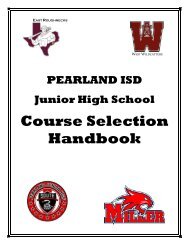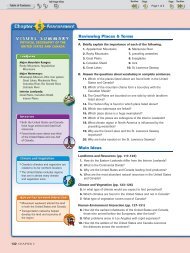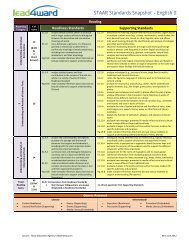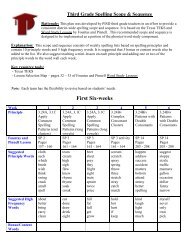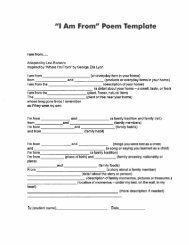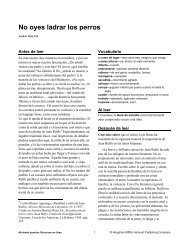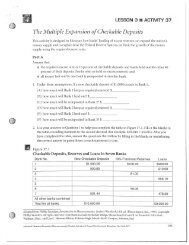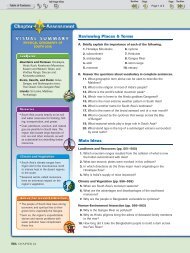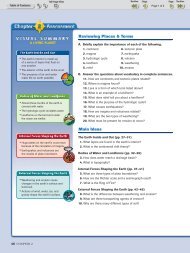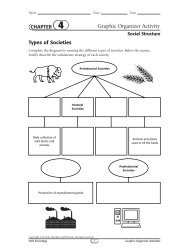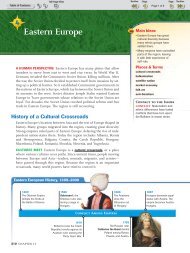Literary Lexicon
Literary Lexicon
Literary Lexicon
Create successful ePaper yourself
Turn your PDF publications into a flip-book with our unique Google optimized e-Paper software.
PLOT<br />
The sequence of events or<br />
actions in a short story,<br />
novel, play, or narrative<br />
poem<br />
Exposition<br />
The author lays the groundwork for<br />
the story by revealing the<br />
Setting<br />
Relationships between the<br />
characters<br />
Situation as it exists before<br />
conflict begins<br />
Rising Action<br />
The action and events that take<br />
place in the story and build up to the<br />
critical moment when the main<br />
conflict is confronted<br />
Falling Action<br />
Events that occur after the climax<br />
and lead up to the closure and<br />
conclusion of the story<br />
Inciting<br />
Incident/Conflict<br />
Interrupts the peace and balance of<br />
the situation and one or more of the<br />
characters comes into conflict with<br />
an outside force, himself, or another<br />
character<br />
Climax<br />
The most critical moment in the<br />
story; the point at which the main<br />
conflict is at its highest point<br />
Resolution<br />
The problem set up in the inciting<br />
incident is unraveled; there is a<br />
revelation of meaning<br />
Adjusted from Davis/Lucas - 8 th Reading for Blancas-7 th Grade Reading<br />
Revised 5/20/2013
Allusion<br />
Irony<br />
Symbol<br />
A reference to a literary,<br />
mythological, or historical<br />
person, place, or thing<br />
A contrast between appearances and<br />
reality – usually one in which reality is the<br />
opposite from what it seems; when one<br />
thing is expected to happen or be, and the<br />
exact opposite happens<br />
The use of any object, person, place,<br />
or action that both has a meaning in<br />
itself and that stands for something<br />
larger than itself, such as a quality,<br />
attitude, belief, or value<br />
Foreshadowing<br />
Anecdote<br />
Setting<br />
The use in a literary work of<br />
clues that suggest events that<br />
have yet to occur<br />
A short account of a particular incident<br />
or event especially of an interesting or<br />
amusing nature<br />
The background against which action<br />
takes place<br />
The geographical location<br />
The occupations and daily manner of living<br />
of the characters<br />
The time or period in which the action takes<br />
place<br />
<br />
The general environment of the characters,<br />
i.e. social, moral, emotional<br />
Suspense<br />
Stereotype<br />
Archetype<br />
The quality of a literary work<br />
that makes the reader uncertain<br />
or tense about the outcome or<br />
situation<br />
The act of putting people into groups<br />
based on race, religion, physical<br />
appearance, social class or some other<br />
easily identifiable characteristic<br />
A typed of character, action, or<br />
situation that occurs over and over in<br />
literature; a pattern or example that<br />
occurs in literature and life<br />
Tone<br />
Theme<br />
Point of View<br />
The writer’s attitude or feeling<br />
toward a person, a thing, a place,<br />
an event or situation<br />
A central message or insight into life<br />
revealed through the literary work; a<br />
lesson about life or people<br />
The perspective from which a story is<br />
told.<br />
Mood<br />
Sensory Language (Imagery)<br />
Detail<br />
The feeling created in<br />
the reader by a literary<br />
work or passage<br />
The words or phrases a writer uses to represent persons, objects,<br />
actions, feelings, and ideas descriptively by appealing to the five<br />
senses (sight, sound, smell, taste, and touch)<br />
Facts revealed by the<br />
author or speaker that<br />
support the attitude or<br />
tone in the work<br />
Emphasis<br />
Emphasis is created by the use of:<br />
When important aspects of a<br />
story are given important<br />
positions and in-depth<br />
development<br />
<br />
<br />
<br />
<br />
Repetition – reiteration of a word, sound, phrase, or idea<br />
Parallelism – the arrangement and repetition of words, phrases, or sentence<br />
structures. Parallelism adds rhythm and emotional impact to writing.<br />
Extensive Detail/Description<br />
Mechanical Devices such as capitalization, italics, symbols, and/or different<br />
colors of ink<br />
Adjusted from Davis/Lucas - 8 th Reading for Blancas-7 th Grade Reading<br />
Revised 5/20/2013
CHARACTERIZATION<br />
Motivation<br />
Dynamic Character<br />
The method used by an author to<br />
create a character, including<br />
The character’s physical<br />
appearance<br />
The character’s own speech,<br />
thoughts, actions, and/or feelings<br />
OTHER characters’ speech,<br />
thoughts, actions, and/or feelings<br />
about the character<br />
Direct comments by the author<br />
about the character<br />
A reason that explains a character’s<br />
thoughts, feelings, actions, or<br />
behavior<br />
Protagonist<br />
The central character and focus of<br />
interest who is trying to accomplish<br />
or overcome an adversity and has the<br />
ability to adapt to new circumstances<br />
A character that undergoes a change<br />
in actions or beliefs during the<br />
course of a story<br />
Static Character<br />
A character that does not grow or<br />
change throughout the story, that<br />
ends as he/she began<br />
Antagonist<br />
The character opposing the<br />
protagonist; can be a person, idea, or<br />
force<br />
DICTION<br />
Denotation<br />
Word choice.<br />
An author often chooses a word, because it suggests a<br />
connotative meaning that comes from its use in various<br />
social contexts.<br />
The specific dictionary definition of a word<br />
Connotation<br />
The emotions or associations a word normally arouses in<br />
people using, hearing, or reading the novel<br />
A word may have a POSITIVE connotation, a<br />
NEGATIVE connotation, or a NEUTRAL<br />
connotation<br />
Point of View<br />
First Person<br />
Third Person Objective<br />
Perspective or position from which a<br />
story is told<br />
<br />
<br />
<br />
<br />
The narrator uses “I”<br />
throughout the story<br />
The narrator is one of the<br />
characters in the story<br />
The narrator’s vantage point<br />
is “inside” the story<br />
The narrator can reveal his<br />
or her feelings and thoughts<br />
<br />
<br />
<br />
The narrator does not reveal<br />
any of the thoughts of any of<br />
the characters<br />
The narrator does not make<br />
any observations<br />
The story is told in a matterof-fact<br />
manner, with no<br />
emotion involved<br />
Third Person Limited<br />
Third Person Omniscient<br />
<br />
<br />
The narrator tells the story<br />
through the eyes, mind, and<br />
emotions of only ONE<br />
character<br />
The observations are told in<br />
third person: “he”, “she”, “they”<br />
<br />
<br />
<br />
The narrator peers into the<br />
hearts and minds of several<br />
characters<br />
The narrator comments on<br />
the behavior, thoughts, and<br />
motivations of many<br />
characters<br />
The narrator tells the story,<br />
but from the perspective of a<br />
third-person who knows all<br />
Adjusted from Davis/Lucas - 8 th Reading for Blancas-7 th Grade Reading<br />
Revised 5/20/2013
FIGURES OF SPEECH<br />
Simile<br />
Personification<br />
Words or phrases that describe<br />
one thing in terms of something<br />
else; always involve some sort of<br />
imaginary comparison between<br />
seemingly unlike things; not<br />
meant to be taken literally.<br />
A comparison of two different things or ideas<br />
through the use of the words LIKE or AS<br />
Metaphor<br />
Writing that gives animals,<br />
inanimate objects, or<br />
abstract ideas human<br />
characteristics.<br />
A comparison of two unlike things not using like or as<br />
Pun<br />
A play on words that are<br />
identical or similar in sound but<br />
have sharply different meanings.<br />
Puns can have serious as well as<br />
humorous uses.<br />
Idiom<br />
An accepted phrase or expression having a meaning<br />
different from the literal<br />
Analogy<br />
Comparison between two similar things<br />
Hyperbole<br />
A deliberate,<br />
extravagant, and often<br />
outrageous exaggeration;<br />
may be used for either<br />
serious or comic effect<br />
Proverb<br />
An often used short<br />
saying that expresses a<br />
general truth or rule<br />
CONFLICT<br />
A struggle between two opposing<br />
forces<br />
Character vs. Self<br />
(Internal)<br />
When a character must make a<br />
decision about a problem or struggle<br />
he is having within himself<br />
Character vs. Nature<br />
(External)<br />
When a character has a problem with<br />
a force of nature such as cold,<br />
storms, earthquakes, etc.<br />
Character vs. Character<br />
(External)<br />
When a character has a problem with<br />
another character<br />
Character vs. Society<br />
(External)<br />
When a character has a problem with<br />
a tradition or rule of society<br />
Character vs. Fate<br />
(External)<br />
When a character has a problem with<br />
something he can’t do anything about,<br />
such as God, luck, death, etc.<br />
Comparison<br />
Showing the similarities between two<br />
of more things<br />
Contrast<br />
Showing the differences between<br />
two or more things<br />
Venn Diagram<br />
Type of graphic organizer used to<br />
show how things are alike and how<br />
they are different<br />
Adjusted from Davis/Lucas - 8 th Reading for Blancas-7 th Grade Reading<br />
Revised 5/20/2013
Genre<br />
Types of writing<br />
Expository Writing<br />
Informs or explains about a topic<br />
Narrative<br />
Type of writing that tells a story<br />
Periodical<br />
Any newspaper or magazine<br />
published regularly<br />
Folktale<br />
Story passed down from one<br />
generation to the next<br />
Fable<br />
Brief tale, usually about an animal, that<br />
teaches a moral or a lesson<br />
Legend<br />
Story from the past, often about a<br />
famous person or event, based at least<br />
somewhat on historical fact<br />
Myth<br />
Story that attempts to explain something<br />
about the world<br />
<br />
Biography<br />
Writing of or about another<br />
person’s life<br />
<br />
<br />
<br />
<br />
<br />
<br />
<br />
Autobiography<br />
Writing about one’s own life<br />
Structure-Short book or<br />
chapters<br />
Content-Real people,<br />
places, events<br />
Purpose-tell thoughts,<br />
feelings, observations to<br />
others; inform, explain,<br />
entertain<br />
Diary<br />
Structure-Dated entries in<br />
order of time<br />
Content-Real people,<br />
places, events<br />
Purpose-To record<br />
thoughts, feelings,<br />
observations for self<br />
Persuasive<br />
Intended to change or influence opinion<br />
Rhetorical Fallacies<br />
An argument that seems convincing but is<br />
based on bad logic, emotional<br />
manipulation or both.<br />
Argument<br />
A case built for or against something<br />
Factual Claim<br />
Can be proven with data, observations,<br />
and reliable sources<br />
Common Knowledge<br />
Information that is known by many<br />
people or that can be found in a<br />
number of different sources<br />
Commonplace Assertion<br />
Statement that many people assume<br />
to be true but which may or may not<br />
be so<br />
Exaggeration<br />
An overstatement of a fact or an<br />
idea; often meant to frighten<br />
Categorical Claim<br />
A claim based on an incorrect<br />
comparison between two things<br />
Generalizations<br />
Broad statement based on<br />
examples or instances<br />
Ad Hominem<br />
An attack on a person or people<br />
making a claim instead of<br />
addressing the claim itself<br />
Poetry<br />
Type of literature, usually written in lines<br />
and stanzas, that combines words, sounds,<br />
imagery, and rhythm to create meaning<br />
Rhyme<br />
Repetition of sounds at the ends of words,<br />
as in spot and dot<br />
Rhythm<br />
Arrangement of stressed and unstressed<br />
beats<br />
Lyric<br />
Expresses the thoughts and feelings of a<br />
single speaker, often in highly musical verse<br />
Narrative Poetry<br />
Poetry tells a story in verse.<br />
Narrative poems often have<br />
elements similar to those in short<br />
stories, such as plot and<br />
characters<br />
Haiku<br />
A three-line Japanese verse form.<br />
The first and third lines each<br />
have five syllables and the second<br />
line has seven<br />
Free Verse<br />
Is defined by its lack of strict<br />
structure. It has no regular<br />
meter, rhyme, fixed line length, or<br />
specific stanza pattern<br />
Ballads<br />
Songlike poems that tell stories. They<br />
often deal with adventure and romance<br />
Concrete<br />
Poems that are shaped to look like<br />
their subjects. The poet arranges the<br />
lines to create a picture on the page<br />
Limericks<br />
Humorous, rhyming, five-line poems<br />
with a specific rhythm pattern and<br />
rhyme scheme<br />
Rhyming Couplets<br />
Pairs of rhyming lines, usually of the<br />
same meter and length<br />
Adjusted from Davis/Lucas - 8 th Reading for Blancas-7 th Grade Reading<br />
Revised 5/20/2013
T Title<br />
P Paraphrase<br />
C Connotation<br />
A Attitude<br />
S Shift<br />
T Title<br />
T Theme<br />
Before you even think about reading the poetry or trying to analyze it, speculate on what you think the poem might<br />
be about based upon the title. Jot down what you think this poem will be about.<br />
When you paraphrase a poem, write in your own words exactly what happens in the poem. Look at the number of<br />
sentences in the poem—your paraphrase should have exactly the same number.<br />
Although this term usually refers solely to the emotional overtones of word choice, for this approach the term refers<br />
to any and all poetic devices, focusing on how such devices contribute to the meaning, the effect, or both of a<br />
poem. You may consider imagery, figures of speech (simile, metaphor, personification, symbolism, etc), diction,<br />
point of view, and sound devices (alliteration, onomatopoeia, rhythm, and rhyme). It is not necessary that you<br />
identify all the poetic devices within the poem. The ones you do identify should be seen as a way of supporting the<br />
conclusions you are going to draw about the poem.<br />
Examination of diction, images, and details suggests the speaker's attitude and contributes to understanding. You<br />
may refer to the list of words on Tone that will help you. Remember that usually the tone or attitude cannot be<br />
named with a single word think complexity.<br />
Rarely does a poem begin and end the poetic experience in the same place. As is true of most us, the poet's<br />
understanding of an experience is a gradual realization, and the poem is a reflection of that understanding or<br />
insight. Watch for the following keys to shifts:<br />
• key words, (but, yet, however, although)<br />
• punctuation (dashes, periods, colons, ellipsis)<br />
• stanza divisions<br />
• changes in line or stanza length or both<br />
• irony<br />
• changes in sound that may indicate changes in meaning<br />
• changes in diction<br />
Now look at the title again, but this time on an interpretive level. What new insight does the title provide in<br />
understanding the poem?<br />
What is the poem saying about the human experience, motivation, or condition? What subject or subjects does the<br />
poem address? What do you learn about those subjects? What idea does the poet want you take away with you<br />
concerning these subjects? Remember that the theme of any work of literature is stated in a complete sentence.<br />
Playwright<br />
the author of a play<br />
Actors<br />
people who perform<br />
the drama<br />
Acts<br />
units of action<br />
Scenes<br />
acts are divided into<br />
these parts<br />
Stage<br />
Directions<br />
information about<br />
where the action<br />
takes place or how it<br />
is done<br />
Theater<br />
place where plays are<br />
performed<br />
Characterization<br />
playwright’s method for<br />
creating believable<br />
characters<br />
Dialogue<br />
a conversation between or<br />
among characters<br />
Monologue<br />
a long speech by a single<br />
character that reveals his<br />
or her thoughts and<br />
feelings<br />
Set<br />
everything on stage that<br />
suggests the time and<br />
place<br />
Props<br />
small items that the actors<br />
use or carry to make their<br />
actions seem real<br />
Comedy<br />
a drama with a happy ending. Comedies are written to entertain and make people<br />
laugh. Comedies often point out faults in people or society.<br />
Tragedy<br />
an unhappy drama that ends with the downfall of the main character. The main<br />
character can be an average person or a person of great importance. Often, the<br />
main character is a heroic figure<br />
Drama<br />
is written about serious subjects such as events that happen in everyday life.<br />
Dramas may not have a comedic or a tragic tone. Drama often takes place on a<br />
stage in a theater. Stage plays require actors, costumes, lights, and sets. Other types<br />
of drama are not performed on stage.<br />
Screenplays<br />
are scripts for films. Screenplays include directions not only for actors but also for<br />
camera operators. They usually have more scene changes than a stage play<br />
Teleplays<br />
are scripts for television. They also include directions for camera operators and<br />
have more scene changes than a stage play<br />
Radio Plays<br />
are scripts for radio broadcasts. They include sound effects. Radio plays do not<br />
require sets, costumes, or directions for actors or camera operators about<br />
movement<br />
Adjusted from Davis/Lucas - 8 th Reading for Blancas-7 th Grade Reading<br />
Revised 5/20/2013


